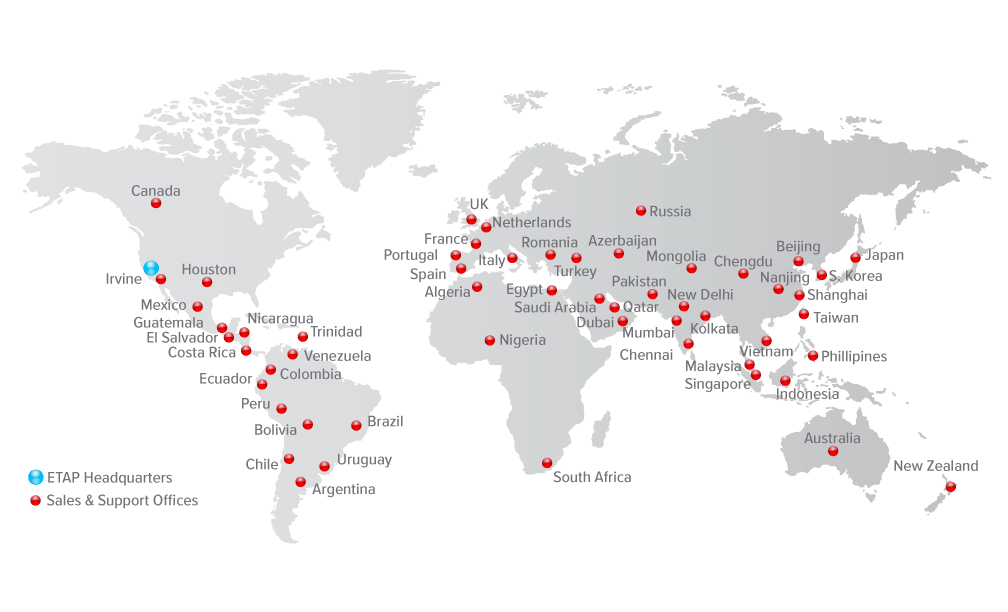ETAP vs DIgSILENT - Power Systems Planning Software
For an engineer, tools are a significant asset. Eventhough if
licenses can be
shared collectively, analysis is the key.
Based on their applications, there are two common types of power system modeling software:
1. Long-term planning modeling software :: Provides design
testing and verification features for various scenarios, enabling proper
planning and optimization of network operations. This first type can be further
divided into three categories:
- Power network analysis-focused (the focus of this article).
- Energy system evolution models (accounting for energy mix changes, e.g., LEAP, TIMES, Excel).
- Economic models (e.g., HOMER).
2. Operational and real-time modeling software :: Serves as an interaction method for control technicians in their supervisory and management roles (e.g., SCADA, DMS, EMS).
This article will discuss power network analysis planning platforms. Typically, these offer functionalities including:
- Transmission systems & generator connections :: Load flow, reactive power capability, fault ride through (generator recovery after disturbances), contingency analysis, harmonic analysis, and electromagnetic transient (EMT) simulations (to verify model accuracy in the frequency domain, often for lightning/switching/overvoltage studies and insulation coordination).
- Distribution networks :: Reverse power flow, voltage management, stability, and protection coordination.
- Integration with real-time systems.
- Hybrid analysis/integration with other electrical equipment.
- Study outputs can serve as Grid/Distribution Code compliance evidence, provided input data/assumptions are sufficiently accurate.
As someone with a background in Power Systems Studies, the title topic is often brought up casually. It even appears briefly in the introductory chapter of class. Hence, I’m sharing this research to keep office conversations smooth, haha!
The Importance of Virtual Modeling
Digitalization in power systems relies on virtual models that simulate real-world behavior and characteristics. Each tool has unique algorithms, features, and traits.
Since reading ≠ doing, I validated findings through observation and experience. It should be noted that the comparison refers to ETAP 20 and DIgSILENT PowerFactory 2021 versions. Here’s my conclusion:
Three Categories of Power Network Analysis Software
1. Large scale system modeling :: For users whose primary
work involves simulation and modeling. These offer advanced frequency-domain
modeling but sacrifice user-friendliness (e.g., PowerWorld [supports 250,000
buses], PSS SINCAL, IPSA).
2. Occasional use programs :: Designed for simpler interfaces
at the cost of advanced modeling (e.g., ETAP, EDSA, PSS/E, NEPLAN, CYME [ref. 5
notes its power], ERACS, EZPower, SKM [claims 90% US user adoption]).
3. Generic differential equation simulators :: Ideal for
detailed equipment behavior modeling (e.g., MATLAB Simulink, PSCAD). Larger
grids are represented via simplified components.
ETAP vs. DIgSILENT: Key Comparisons
1. Advanced Modeling :: DIgSILENT excels in small-signal stability & EMT for transmission systems (eigenvalue plotting, system stability checks). ETAP lacks this. DIgSILENT also supports distributed cable models (vs. ETAP’s PI model).2. Transmission System & Dynamic Reactive Power :: DIgSILENT PF outperforms ETAP.
3. Protection Features
- ETAP: Includes Z-Star (REF & differential protection), fuse modeling, ANSI functions (overcurrent, earth fault), and superior Arc Flash analysis. Interactive fault validation highlights coordination errors.
- DIgSILENT: Better for transmission protection (underfrequency relays, load shedding, differential/distance protection).
4. Scenario Management :: ETAP’s Scenario Wizard optimizes
designs by comparing revisions. DIgSILENT uses basic Operation Scenarios but
lacks automation. Both suit revision-heavy engineers.
5. Microgrid Control :: ETAP leads with time-domain load flow
for wind/solar/BESS/inverter modeling (off-grid & grid-following modes).
DIgSILENT’s off-grid support is limited.
6. Component Modeling
- Switchgear: DIgSILENT supports double busbar configurations (with bus couplers); ETAP requires separate LL/LG,N/LE modeling.
- Transformers: DIgSILENT offers Zigzag types, NGR, and phase-shifting; ETAP has Open Delta.
- Cables: DIgSILENT includes transposed lines and Parameter G
- Induction Motors: ETAP wins with product databases and starter/VFD models.
7. Parameter Calculations
- ETAP auto-calculates linked parameters (e.g., transformer MVA → kW/pf).
- DIgSILENT requires manual X/R or SCR calculations but has a transformer library.
8. Licensing :: ETAP’s features are split (basic vs.
premium). Premium includes ETRAX (rolling stock design), Auto Build, SCADA
Digital Twin, and API links (Revit, ArcGIS, DIgSILENT).
9. Learning Resources :: ETAP offers free webinars/certified
training and YouTube tutorials. DIgSILENT relies on YouTube but provides
detailed paid course syllabi.
10. Regional Adoption ::
- DIgSILENT: Latin America (Peru, Spain), Europe (UK, Croatia, Germany), Turkey.
- ETAP: US, India, Southeast Asia. Preferred in process/manufacturing; DIgSILENT dominates transmission.
Future Trends: AI & Automation
- Automated analysis & templating :: AI could handle repetitive design tasks (e.g., "if A, then B" logic).
- Software integration :: APIs/add,ins (e.g., PVSyst, SketchUp, AutoCAD, ETAP/DIgSILENT). PVSyst 8.1 already supports CLI programming.
- Engineer upskilling :: Certifications in AI/ML, APIs, and cloud tech may soon complement (or compete with) traditional engineering roles.
Thoughts? Comments and feedback are welcome!
References
[1] Abbasian, Saman. 2023. https://www.linkedin.com/posts/saman-abbasian-6240b34b_powerdistribution-etap,digsilent-activity-7150489550476288000-VHdV/
[2] DIgSILENT Resources (Web & User Manual). 2024
[3] ETAP Resources (Web & User Manual). 2024
[4] Ferguson, S. Hay, Anna. 2015. A Review of Power Systems
and Modelling Platform. IET
[5] Unknown. https://pdfcoffee.com/cyme-neplan-sincal-digsilent-psse-etap-pdf-free.html
[6] Unknown. https://www.slideshare.net/slideshow/different-simulation-softwares-in-power-system-194495400/194495400.





Post more about etap
Gud info